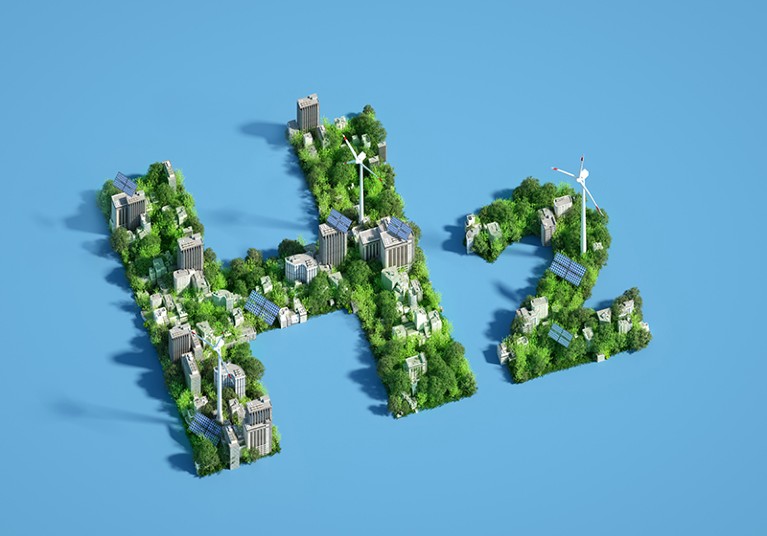
Credit: Adriy Onufriyenko/Getty
Hydrogen has been billed as a ‘green fuel’ for the future because it’s carbon-free at the point of use. There’s no shortage of ways to produce it, but these techniques have a crucial flaw: they all produce carbon, too.
The pursuit of a more sustainable, cost-efficient way to generate hydrogen was chosen in 2021 to be one of the first focuses of the European Union’s European Innovation Council (EIC) Pathfinder Challenge. This is a new funding mechanism that supports a portfolio of research projects, led by scientists and engineers from various disciplines, to tackle the same fundamental problems. Launched that year, the programme encourages a holistic approach to EU-directed challenges, with a view to ferrying the best innovations to market. The programme has given grants of up to €4 million (US$4.4 million), with no expectations about the number of partners in a consortium or the duration of projects. So far, the challenge counts 86 projects in its portfolio, totalling a commitment of €312 million.
In 2021, the EIC funded other portfolio themes, including emerging cell and gene-therapy technologies; engineered living materials; tools to measure and stimulate brain tissue activity; and awareness and consciousness in artificial intelligence.
Marketplace mentality
“The story of hydrogen will be a success only if it’s a story about innovation,” says José Miguel Bermúdez Menéndez, an energy technology analyst for hydrogen and alternative fuels at the Paris-based International Energy Agency. To get to net-zero greenhouse-gas emissions by 2050, a target that the European Commission committed to as a party to the 2015 Paris climate agreement, hydrogen technology needs to be feasible for widespread use in shipping and aviation, he says.
The Pathfinder Challenge aims to do more than just hand out grants. Each project has an innovation manager tasked with investigating how to commercialize intellectual property resulting from the research.
The EIC “identifies where research innovation should go on the basis of specific evidence of what is missing in Europe, and so it is a completely different approach”, says Antonio Marco Pantaleo, an energy systems and green technology programme manager at the EIC, who oversees the hydrogen-challenge portfolio. Programme managers such as Pantaleo have the authority to change the focus of projects funded by the challenge. They are appointed to develop a vision for the technologies that the European Council wants to bring to market.
ANEMEL, an initiative that aims to transform dirty water into clean hydrogen using a technique called anion exchange membrane electrolysis, is one of ten projects included in the hydrogen portfolio. Led by Pau Farràs, an inorganic chemist at the University of Galway in Ireland, ANEMEL is searching for a greener way to split water into hydrogen and oxygen by using catalysts that are more abundant and sustainable.
Collaboration is key
Projects such as ANEMEL must interact and exchange knowledge with eight other projects in the same portfolio — a precondition that the European Commission hopes will create a synergizing effect. “The EIC were very much interested in having this almost-open collaboration,” says Farràs. Research teams across all projects meet at least once a year, with most collaboration coming through bilateral exchanges on projects that have clear overlap.
Not everyone is happy with the Pathfinder Challenge scheme, however, says Pantaleo. “We give specific intellectual property rights to the inventors, rather than to the university where the research is produced.” This, he says, has ruffled some feathers at research institutes across Europe, which have experience in helping researchers to develop intellectual properties.
There is the risk that this focus on the invention and not on the role of the inventors’ institution “could make these funding mechanisms less attractive for some universities that are very, very strong and very good in developing spin-off start-ups,” says Pantaleo. But he adds that the Pathfinder Challenge represents “a new culture and a new way to support research and innovation”.
Whether this new culture succeeds in commercializing research to alleviate some of the world’s most pressing problems is something that funders in Brussels will be keen to assess in the coming years. For now, Farràs says, the biggest challenge for the scheme is finding a common footing on which the projects can collaborate. “We are all still learning how to have a proper communication between the different projects in the portfolio,” he says. “This is still a work in progress. I think that we’ll need to see how this evolves.”

 UK scientists fear they will be locked out of €100 billion EU research programme
UK scientists fear they will be locked out of €100 billion EU research programme
 UK, please drop the rhetoric and fight for collaboration with Europe
UK, please drop the rhetoric and fight for collaboration with Europe
![High carrier mobility along the [111] orientation in Cu2O photoelectrodes](https://media.nature.com/w140h79/springer-static/image/art%3A10.1038%2Fs41586-024-07273-8/MediaObjects/41586_2024_7273_Fig1_HTML.png)





